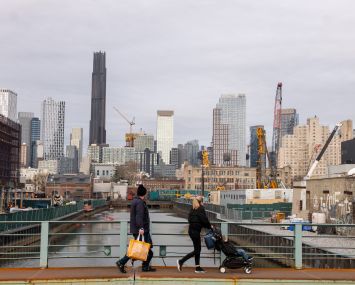Keeping Pace: As One-Time Commuter School Expands, Retailers and Students Clamor for Space in Lower Manhattan buildings
By Billy Gray March 19, 2013 8:00 am
reprintsWhen David Falk toured Pace University’s new dormitory at 180 Broadway in January, he was struck not only by the gleaming facilities but also by what they said about the 107-year-old school.
Mr. Falk, the New York tristate region president of Newmark Grubb Knight Frank, has worked with the university since 1999. The new building “is beautiful,” Mr. Falk said. “It’s the new Pace.”
The transformed school has helped alter the real estate landscape of lower Manhattan. In the past 15 months, Pace has inked deals for the entire 47,000 square feet at 140 William Street, renewed a 32,707-square-foot office lease at 156 William Street, and, with partner SL Green (SLG), announced plans for a 30-story dormitory at 33 Beekman Street.
The 220,000-square-foot 180 Broadway—also a joint project with SL Green—came to light in the darkest days of the recession. Pace wanted to bring about 600 beds back to its lower Manhattan campus from Brooklyn Heights.

“We started looking into residential buildings,” Mr. Falk said. “This was post-Lehman Brothers, so the neighborhood was quiet. We quickly realized that there was too much wasted space in apartment buildings. As anyone who can remember his college days knows, dorms are cookie-cutter spaces that can be lined up.”
By bringing dormers back into the traditional heart of its campus, Pace bucked the education sector’s trend toward expanding into far-flung territories. In addition to (controversially) bulking up its Greenwich Village footprint, New York University plans to create an applied-sciences institute in Downtown Brooklyn and touch down on Governor’s Island. Columbia University’s $6.3 billion Manhattanville project will bring the Ivy into a huge new swatch of Harlem.
“Pace wants to keep growing its presence and image around the existing campus in lower Manhattan,” Mr. Falk said. The university is also working to consolidate its Westchester campuses.
But while Pace’s real estate is concentrated below Canal Street, its student body reflects a growing geographic diversity. “It was at one time a commuter school,” Mr. Falk said. “Now, people across the country want to be here.” Students from outside New York are particularly drawn to Pace’s nursing, dance and theater programs. The dance and visual arts schools will occupy 140 William Street.
The influx of students—and residents not affiliated with Pace—has reshaped lower Manhattan, which until recently was considered a veritable ghost town once the markets closed. “It’s creating a 24/7 community,” Mr. Falk said. “You walked around there at night 15 years ago and it was desolate. Now, these students actually want to be there.”
Retailers—especially those who cater to young shoppers—also want in. Earlier this month, Urban Outfitters—an undergraduate-friendly store if ever there was one—signed a 21,000-square-foot lease at 180 Broadway.
Meanwhile, the local fury that has greeted NYU and Columbia’s expansion projects has not boiled up over Pace’s developments. That can be explained in part by the real estate the university inhabits. “I wouldn’t use the word obsolete, but they’re looking at more of the Class B products,” said Kyle Ciminelli, a managing director at Newmark who has worked with Mr. Falk on several Pace transactions. “They’re top-notch landlords, but prewar products. Plus, there’s so much construction going on Downtown that you can hardly differentiate one project from another.”
That said, 180 Broadway and 33 Beekman sprung from development sites. The transformative aspect of those properties is another lure for Pace’s broadened applicant pool and is a testament to both the university’s sway over lower Manhattan and the neighborhood’s unlikely emergence as a destination for tenants and residents from beyond the financial sector.
“Pace will have two brand-new buildings that students will be thrilled with,” Mr. Falk said. “It goes hand in hand with where Pace is going as a university. When people see it, they’ll want to be here.”


